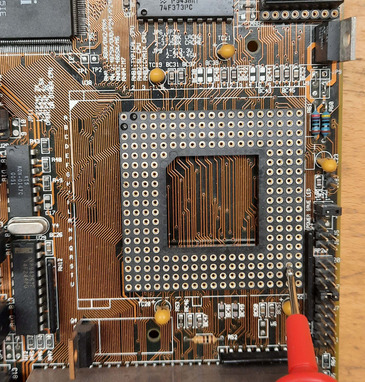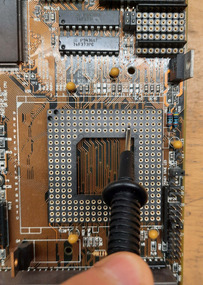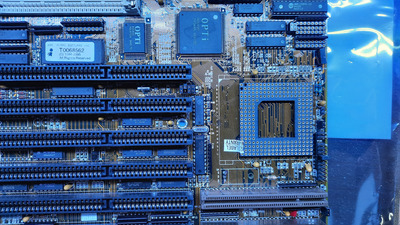First post, by cendof
Hello,
recently I got two Motherboards PAT48PG, both version 0.30, nice as it is VLB. Both equipped with an 3.3V/3.45 V option->be aware that this is auto voltage detection motherbaord via VOLDET pin (S4) on processor, so check processor datasheet first; one of mine Cyrix Cx486DX2-v80 (3.45 V) is not good as it is without VOLDET pin. On first motherboard elements Q3 (transistor), Q4 (transisotr) and TC21 (capacitor) were blown (attached image). So I removed them and using pictures from internet and some soldering I got "only" 5 V version running now i486DX2-66. 😀 I have also removed a wire on the processor Socket 3 jumping pins B13 and R17 as pictures from internet did not have this wire. This board had a severe battery leak and I had to rewire quite a lot of traces and now it's quite ok, only the processor is recognized as DX4-100. I did not solve this issue till now as I have other projects, I suspect problem with jumper W8 and signals passing further.
After a while I got another board, the same type and version with all 3.3V/3.45V elements "ok", just Q3 was dead...so I replaced it. I searched the internet and I did not get type of these elements, so if anybody is searching for them...element Q3 is voltage regulator LT1085CT, element Q4 is MOSFET transistor F25N05L, resistor R61 is 270R+/-1% and resistor R60 is 470R+/-1%, capacitor TC21 is 10uF 16V Radial Dipped Tantalum Capacitor. When powering MB on I have 3.45 V (quite good) and also when am486DX4-100 is inserted I got BIOS post codes; still error 05 04 (keyboard controller as it seems for now). I did not solve this, yet.
What is bothering me is a wire between Socket 3 pins (processor marks) B13 and R17 as described above. In Intel documentation these pins are WB/WT# and CLKMUL. I really don't know at this moment what for this short is and if it is special for only 3.3V/3.45 V version and on "only" 5V version this wire would cause problems.
Thank you for any suggestions and further information.


